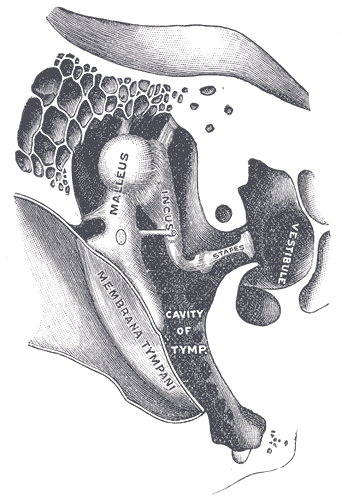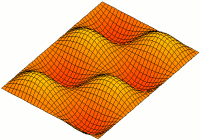|
Tone Variator
German psychologist William Stern invented the tone variator in 1897 to study human sensitivity to changes in pitch, going beyond the traditional psychophysical research of studying the sensitivity to differences in discrete tones. The instrument consists of an adjustable brass resonator, which is supplied with a constant flow of air across the opening at the top. Turning a graduated cam on the front of the apparatus raises or lowers a piston in the bottom of the resonator, changing the volume of its interior, thus altering the sounded pitch over a continuous range. The spiral-shaped cam is such that equal angles of rotation approximately correspond to equal changes in frequency. A dial on the front of the cam indicates the current resonance frequency and musical tone of the instrument. Subsequent improvements to the device include the addition by G. M. Whipple of a gasometer, in order to regulate the incoming air supply. A version of the device was also produced in which the b ... [...More Info...] [...Related Items...] OR: [Wikipedia] [Google] [Baidu] |
William Stern (psychologist)
William Stern (April 29, 1871 – March 27, 1938), born Ludwig Wilhelm Stern, was a German psychologist and philosopher. He is known for the development of personalistic psychology, which placed emphasis on the individual by examining measurable personality traits as well as the interaction of those traits within each person to create the self. Stern also coined the term intelligence quotient, or IQ, and invented the tone variator as a new way to study human perception of sound. Stern studied psychology and philosophy under Hermann Ebbinghaus at the University of Berlin, and quickly moved on to teach at the University of Breslau. Later he was appointed to the position of professor at the University of Hamburg. Over the course of his career, Stern wrote many books pioneering new fields in psychology such as differential psychology, critical personalism, forensic psychology, and intelligence testing. Stern was also a pioneer in the field of child psychology. Working with his ... [...More Info...] [...Related Items...] OR: [Wikipedia] [Google] [Baidu] |
Variator
A variator is a device that can change its parameters, or can change parameters of other devices. Often a variator is a mechanical power transmission device that can change its gear ratio continuously (rather than in steps). Examples * Beier variable-ratio gear * Continuously variable transmission * Evans friction cone * NuVinci Continuously Variable Transmission * Variator (variable valve timing) * Variomatic * VANOS See also * Epicyclic gearing An epicyclic gear train (also known as a planetary gearset) consists of two gears mounted so that the center of one gear revolves around the center of the other. A carrier connects the centers of the two gears and rotates the planet and sun gea ... Mechanical power control {{Mech-engineering-stub ... [...More Info...] [...Related Items...] OR: [Wikipedia] [Google] [Baidu] |
Hearing
Hearing, or auditory perception, is the ability to perceive sounds through an organ, such as an ear, by detecting vibrations as periodic changes in the pressure of a surrounding medium. The academic field concerned with hearing is auditory science. Sound may be heard through solid, liquid, or gaseous matter. It is one of the traditional five senses. Partial or total inability to hear is called hearing loss. In humans and other vertebrates, hearing is performed primarily by the auditory system: mechanical waves, known as vibrations, are detected by the ear and transduced into nerve impulses that are perceived by the brain (primarily in the temporal lobe). Like touch, audition requires sensitivity to the movement of molecules in the world outside the organism. Both hearing and touch are types of mechanosensation. Hearing mechanism There are three main components of the human auditory system: the outer ear, the middle ear, and the inner ear. Outer ear The ou ... [...More Info...] [...Related Items...] OR: [Wikipedia] [Google] [Baidu] |
Cavity Resonator
A resonator is a device or system that exhibits resonance or resonant behavior. That is, it naturally oscillates with greater amplitude at some frequencies, called resonant frequencies, than at other frequencies. The oscillations in a resonator can be either electromagnetic or mechanical (including acoustic). Resonators are used to either generate waves of specific frequencies or to select specific frequencies from a signal. Musical instruments use acoustic resonators that produce sound waves of specific tones. Another example is quartz crystals used in electronic devices such as radio transmitters and quartz watches to produce oscillations of very precise frequency. A cavity resonator is one in which waves exist in a hollow space inside the device. In electronics and radio, microwave cavities consisting of hollow metal boxes are used in microwave transmitters, receivers and test equipment to control frequency, in place of the tuned circuits which are used at lower fre ... [...More Info...] [...Related Items...] OR: [Wikipedia] [Google] [Baidu] |
Tuning Fork
A tuning fork is an acoustic resonator in the form of a two-pronged fork with the prongs ( tines) formed from a U-shaped bar of elastic metal (usually steel). It resonates at a specific constant pitch when set vibrating by striking it against a surface or with an object, and emits a pure musical tone once the high overtones fade out. A tuning fork's pitch depends on the length and mass of the two prongs. They are traditional sources of standard pitch for tuning musical instruments. The tuning fork was invented in 1711 by British musician John Shore, sergeant trumpeter and lutenist to the royal court. Description A tuning fork is a fork-shaped acoustic resonator used in many applications to produce a fixed tone. The main reason for using the fork shape is that, unlike many other types of resonators, it produces a very pure tone, with most of the vibrational energy at the fundamental frequency. The reason for this is that the frequency of the first overtone is about ... [...More Info...] [...Related Items...] OR: [Wikipedia] [Google] [Baidu] |
Audiology
Audiology (from Latin , "to hear"; and from Greek , '' -logia'') is a branch of science that studies hearing, balance, and related disorders. Audiologists treat those with hearing loss and proactively prevent related damage. By employing various testing strategies (e.g. behavioral hearing tests, otoacoustic emission measurements, and electrophysiologic tests), audiologists aim to determine whether someone has normal sensitivity to sounds. If hearing loss is identified, audiologists determine which portions of hearing (high, middle, or low frequencies) are affected, to what degree (severity of loss), and where the lesion causing the hearing loss is found ( outer ear, middle ear, inner ear, auditory nerve and/or central nervous system). If an audiologist determines that a hearing loss or vestibular abnormality is present, they will provide recommendations for interventions or rehabilitation (e.g. hearing aids, cochlear implants, appropriate medical referrals). In addition t ... [...More Info...] [...Related Items...] OR: [Wikipedia] [Google] [Baidu] |
Health
Health, according to the World Health Organization, is "a state of complete physical, mental and social well-being and not merely the absence of disease and infirmity".World Health Organization. (2006)''Constitution of the World Health Organization''– ''Basic Documents'', Forty-fifth edition, Supplement, October 2006. A variety of definitions have been used for different purposes over time. Health can be promoted by encouraging healthful activities, such as regular physical exercise and adequate sleep, and by reducing or avoiding unhealthful activities or situations, such as smoking or excessive stress. Some factors affecting health are due to individual choices, such as whether to engage in a high-risk behavior, while others are due to structural causes, such as whether the society is arranged in a way that makes it easier or harder for people to get necessary healthcare services. Still, other factors are beyond both individual and group choices, such as genetic disorders. ... [...More Info...] [...Related Items...] OR: [Wikipedia] [Google] [Baidu] |
Medicine
Medicine is the science and Praxis (process), practice of caring for a patient, managing the diagnosis, prognosis, Preventive medicine, prevention, therapy, treatment, Palliative care, palliation of their injury or disease, and Health promotion, promoting their health. Medicine encompasses a variety of health care practices evolved to maintain and restore health by the prevention (medical), prevention and therapy, treatment of illness. Contemporary medicine applies biomedical sciences, biomedical research, medical genetics, genetics, and medical technology to diagnosis (medical), diagnose, treat, and prevent injury and disease, typically through pharmaceuticals or surgery, but also through therapies as diverse as psychotherapy, splint (medicine), external splints and traction, medical devices, biologic medical product, biologics, and Radiation (medicine), ionizing radiation, amongst others. Medicine has been practiced since Prehistoric medicine, prehistoric times, and for most o ... [...More Info...] [...Related Items...] OR: [Wikipedia] [Google] [Baidu] |
Otology
Otology is a branch of medicine which studies normal and pathological anatomy and physiology of the ear (hearing and vestibular sensory systems and related structures and functions) as well as their diseases, diagnosis and treatment. Otologic surgery generally refers to surgery of the middle ear and mastoid related to chronic otitis media, such as tympanoplasty, or ear drum surgery, ossiculoplasty, or surgery of the hearing bones, and mastoidectomy. Otology also includes surgical treatment of conductive hearing loss, such as stapedectomy surgery for otosclerosis. Neurotology, a related field of medicine and subspecialty of otolaryngology, is the study of diseases of the inner ear, which can lead to hearing and balance disorders. Neurotologic surgery generally refers to surgery of the inner ear or surgery that involves entering the inner ear with risk to the hearing and balance organs, including labyrinthectomy, cochlear implant surgery, and surgery for tumors of the ... [...More Info...] [...Related Items...] OR: [Wikipedia] [Google] [Baidu] |
Fechner
Fechner is a surname. Notable people with the surname include: * Carl-A. Fechner (born 1952), German documentary filmmaker * Christian Fechner (1944–2008), French film producer and screenwriter * Gino Fechner (born 1997), German footballer * Gustav Fechner (1801–1887), German experimental psychologist, physicist and philosopher * Harry Fechner (born 1950), German football defender * Johannes Fechner (born 1965), German politician * Max Fechner (1892–1973), Minister of Justice of the GDR * Robert Fechner (1876–1939), American union leader * Sebastian Fechner (born 1983), Polish footballer See also * Fechner color, an illusion of color * Weber–Fechner law * Fechner (crater) Fechner is a lunar impact crater that lies on the far side of the Moon's southern hemisphere, attached to the western rim of the large walled plain Planck. The eastern rim of Fechner intersects the Vallis Planck, a long, wide cleft in the s ..., a lunar crater * 11041 Fechner (1989 SH2), a ... [...More Info...] [...Related Items...] OR: [Wikipedia] [Google] [Baidu] |







